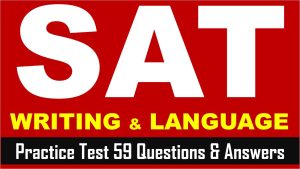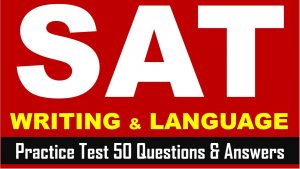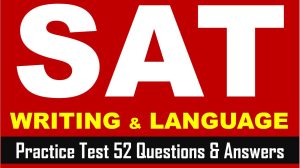Hi SAT Aspirants, welcome to AKVTutorials. As you know SAT (Scholastic Assessment Test) is a standard test, used for taking admission to undergraduate programs of universities or colleges of United States. SAT is developed and published by the College Board, an organization in United States, administered by the Educational Testing Service. Therefore, you need to do practice on SAT Reading Section, SAT Writing and Language Section. In this article, you will get SAT Reading Writing Practice Test 68 with Answer Keys AMBIPi
Instruction:
- In the passage below is accompanied by a number of questions.
- For some questions, you need to think how the passage might be revised to improve the expression of ideas.
- For other questions, you will consider how the passage might be edited to correct errors in sentence structure, usage, or punctuation.
- Some questions will direct you to an underlined portion of a passage.
- Other questions will direct you to a location in a passage or ask you to think about the passage as a whole.
SAT Writing & Language Section Passage
SAT Reading Writing Practice Test Passage Title: The Other Tolstoy
For people born into the Russian aristocracy in the nineteenth century, life was full of interesting opportunities—unless they were female. At the time, women generally did not have careers, 1 who were expected, instead, to focus fully on marrying and raising families. Sophia Behrs was one such young woman. The man she 2 married Leo Tolstoy was one of the world’s greatest writers. When Sophia married Tolstoy, he was already a well-known author. Both members of the couple were literary in 3 its interests: Sophia had been a gifted student and, even at a very young age, was a voracious and sensitive reader. 4
[1] Sophia’s marriage to Leo gave her the opportunity 5 to put her abilities as a good reader to use, often advising him on his work throughout the writing process. [2] She served as her husband’s copyist (since this was before the advent of the typewriter), writing out multiple copies of his novels by hand.[3] She made suggestions for and edits to his work, many of which were 5 inculcated into the final product. [4] In addition, she served as his manager, publicist, and agent, keeping track of the financial and legal sides of her husband’s writing career. [5] She juggled these many roles with grace and skill. [6] If Sophia were alive today, she might have found her calling at a publishing house or literary agency. 6
7 She wrote her own Russian-language grammar textbook and translated texts from German and English.
She also 8 wrote fiction. Including a revision of Leo’s novella Te Kreutzer Sonata. In that story, a man recounts the dramatic breakdown of his marriage; Sophia retold the narrative from his wife’s point of view. The famous writer was himself impressed by his wife’s literary talents. “What force of truth and simplicity!” he wrote in his diary upon reading one of her stories.
9 Furthermore, Sophia never sought publication for her own work. Writing was not a pursuit that she took 10 seriously, rather she regarded the whole enterprise with “a certain contempt and irony.” 11 Sophia was limited by personal modesty, her domestic duties, and the expectations for women in her lifetime. She probably never even considered seeking fame on her own account. Yet Tolstoy would never have been able to produce the work he did without Sophia’s vital contributions.
SAT Reading Writing Practice Test Questions
Question No 1
Which choice best maintains the sentence pattern already established in the paragraph?
Option A : No Change
Option B : for they were expected, instead,
Option C : were instead expected
Option D : yet they were instead expected
Answer
Show/Hide Answer
Option B : for they were expected, instead,
Question No 2
Which of the following options is the most effective?
Option A : No Change
Option B : married Leo Tolstoy, was
Option C : married, Leo Tolstoy was
Option D : married, Leo Tolstoy, was
Answer
Show/Hide Answer
Option D : married, Leo Tolstoy, was
Question No 3
Which choice provides the most effectively transition to the information that follows?
Option A : No Change
Option B : her
Option C : his
Option D : their
Answer
Show/Hide Answer
Option D : their
Question No 4
At this point, the writer wants to add support for a point made in a previous sentence. Which of the following quotations from Sophia’s diary best accomplishes this goal?
Option A : “When I finished David Copperfield, I cried though I were being separated from a close friend,” she wrote.
Option B : “During the first years at Yasnaya Polyana, we lived a very retired life…everything passed us by,” she wrote.
Option C : “Of music and drawing I learned little; I did not have enough time, though throughout my life I have loved all the arts,” she wrote.
Option D : “I was working with a friend, the daughter of the Inspector of the University, and therefore moved in university circles, among intelligent professors and students,” she wrote.
Answer
Show/Hide Answer
Option A : “When I finished David Copperfield, I criedas though I were being separated from a close friend,” she wrote.
Question No 5
Which choice best maintains the sentence pattern already established in the paragraph?
Option A : No Change
Option B : incorporated
Option C : ingrained
Option D : indoctrinated
Answer
Show/Hide Answer
Option B : incorporated
Question No 6
To make this paragraph most logical, Sentence 5 should be placed
Option A : where it is now
Option B : after sentence 1.
Option C : after sentence 2.
Option D : after sentence 3.
Answer
Show/Hide Answer
Option A : where it is now
Question No 7
Which choice most effectively establishes the main topic of the paragraph?
Option A : Sophia had a strong interest in literature, but her husband did not want her to pursue it.
Option B : It was uncommon for upper-class, nineteenth century Russian women to be as educated as Sophia was.
Option C : Sophia also had literary talents of her own and, when she could find the time, turned her hand to her own writing.
Option D : Leo Tolstoy gave Sophia full editorial control over his drafts.
Answer
Show/Hide Answer
Option C : Sophia also had literary talents of her own and, when she could find the time, turned her hand to her own writing.
Question No 8
The writer is considering deleting the underlined sentence. Should the sentence be kept or deleted?
Option A : NO CHANGE
Option B : wrote fiction, including
Option C : wrote. Fiction including
Option D : wrote fiction, it included
Answer
Show/Hide Answer
Option B : wrote fiction, including
Question No 9
Which choice best maintains the sentence pattern already established in the paragraph?
Option A : No Change
Option B : However,
Option C : For that reason
Option D : Likewise,
Answer
Show/Hide Answer
Option B : However,
Question No 10
Which choice best maintains the sentence pattern already established in the paragraph?
Option A : No Change
Option B : seriously; rather,
Option C : seriously, rather;
Option D : seriously, rather:
Answer
Show/Hide Answer
Option B : seriously; rather,
Question No 11
Which choice most effectively combines the sentences at the underlined portion?
Option A : Sophia was limited by personal modesty, her domestic duties, and the expectations for women in her lifetime and, because of them,
Option B : Sophia was limited by personal modesty, her domestic duties, and the expectations for women in her lifetime, and those reasons notwithstanding, she
Option C : Because of the limitations of personal modesty, her domestic duties, and the expectations for women in her lifetime, these were reasons why Sophia
Option D : Limited by personal modesty, her domestic duties, and the expectations for women in her lifetime, Sophia
Answer
Show/Hide Answer
Option D : Limited by personal modesty, her domestic duties, and the expectations for women in her lifetime, Sophia



